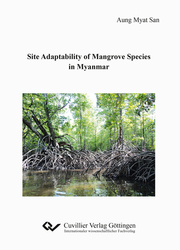| Fachbereiche | |
|---|---|
| Buchreihen (90) |
1263
|
| Geisteswissenschaften |
2249
|
| Naturwissenschaften |
5309
|
| Mathematik | 223 |
| Informatik | 310 |
| Physik | 971 |
| Chemie | 1346 |
| Geowissenschaften | 130 |
| Humanmedizin | 241 |
| Zahn-, Mund- und Kieferheilkunde | 10 |
| Veterinärmedizin | 98 |
| Pharmazie | 147 |
| Biologie | 812 |
| Biochemie, Molekularbiologie, Gentechnologie | 114 |
| Biophysik | 25 |
| Ernährungs- und Haushaltswissenschaften | 44 |
| Land- und Agrarwissenschaften | 992 |
| Forstwissenschaften | 202 |
| Gartenbauwissenschaft | 18 |
| Umweltforschung, Ökologie und Landespflege | 145 |
| Ingenieurwissenschaften |
1714
|
| Allgemein |
91
|
|
Leitlinien Unfallchirurgie
5. Auflage bestellen |
|
Erweiterte Suche
Site Adaptability of Mangrove Species in Myanmar
Aung Myat San (Autor)Vorschau
Leseprobe, PDF (2,3 MB)
Inhaltsverzeichnis, PDF (640 KB)
| ISBN-13 (Printausgabe) | 9783736971516 |
| ISBN-13 (E-Book) | 9783736961517 |
| Sprache | Englisch |
| Seitenanzahl | 292 |
| Umschlagkaschierung | matt |
| Auflage | 1. |
| Erscheinungsort | Göttingen |
| Promotionsort | Göttingen |
| Erscheinungsdatum | 22.01.2020 |
| Allgemeine Einordnung | Dissertation |
| Fachbereiche |
Land- und Agrarwissenschaften
|
| Schlagwörter | Mangrove ecology, silviculture, mangrove inventory, restoration of mangrove ecosystems, site-species matching, species zonation, natural regeneration, salinity, osmotic potentials of plant and soil, sapwood osmotic potential, anoxic soil, oxygen limitation, stable isotopes of nitrogen (δ15N) and oxygen (δ18O), sapwood density, Myanmar |
Beschreibung
Mangroves play an important role in the sustainability of marine ecosystems and provide protective and productive services for the socio-economic development of coastal communities. However, the degradation of the world’s mangroves is severe, and restoration of this unique ecosystem is of global concern. In this light, site-species matching is crucial for successful mangrove reforestation. Understanding the physiological responses of mangroves to limiting ecological factors is essential in selecting site-specific species. Salinity, intertidal dynamics and waterlogged site conditions are the abiotic factors limiting the distribution and growth of mangroves. To cope with the harsh environment, mangroves perform various strategies including osmoregulation, salt secretion, salt storage, aerial root or pneumatophore development and regeneration by vivipary propagules. If the intertidal gradient is favorable, mangroves distribute according to the typical zonation pattern. Saturated leaf osmotic potential and sapwood osmotic potential can be used as site indicators. The pneumatophores of mangrove perform well for gas exchange under waterlogged soil and oxygen limitation could be neglected in species selection. Additionally, participation of local communities is fundamental for the sustainable management of mangrove resources. Planting the optimally-suited species at a given site is highly recommended for the successful restoration of mangrove ecosystems. This book should prove useful in the selection of suitable mangrove species for planting across a range of intertidal zones.








